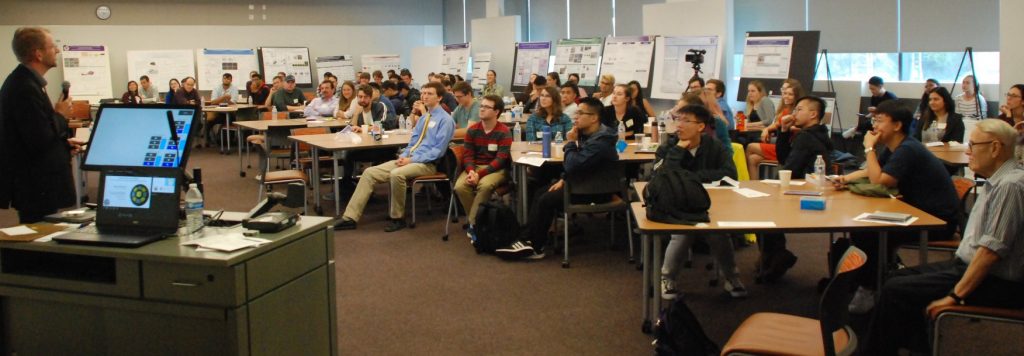2021 Graduate Student Symposium

About the Event
The 2021 GSS will be held September 23rd, 2021 from 13:00 to 18:00 PST.
ACES is committed to providing its students with opportunities for professional development and outreach beyond those typically available during graduate study. Of these, the Graduate Student Symposium (GSS) has been conceptualized with the goal to bridge the gap between industry and academia. For industry representatives this event provides an overview of the exciting research at UW ChemE, and an opportunity to interact with future research leaders and help improve the quality of graduate education. Now in its fourteenth year, our GSS has evolved to become a lively forum for enlightening discussions and knowledge exchange among our students, industry and leaders from the community at large.
Format and Schedule
The event will be held in hybrid format: all activities will be occurring in person and will be digitally accessible via the Zoom link below. All activities are listed in Pacific Daylight Time (PDT).
Zoom link: https://washington.zoom.us/j/94496797874
Note: to obtain the password to access the Zoom link, contact the organizers: Maria Politi [ politim-at-uw-dot-edu ] & Brendan Butler [bpb76-at-uw-dot-edu]
In person location: NanoES Building – Room 181, 3946 W Stevens Way NE, Seattle, WA 98105
Please see below for specifics regarding in-person and remote attendance.
Agenda
- 13:00 – Opening Remarks
- 13:05 – Keynote Speaker:
- Teresa Jurgens-Kowel, Global NP Solutions
- 14:00 – Student Presentation Session I
- 14:30 – 2021 UW Chemical Engineering Early Career Impact Award:
- Líney Árnadóttir, Oregon State University
- 14:50 – Break
- 15:00 – Student Poster Session I
- 15:45 – Industry Panel:
- Janet Matsen, Zymergen
- Kelly Fleming, AAAS
- Mariefel Olarte, PNNL
- 16:30 – Student Presentation Session II
- 17:00 – Student Poster Session II
- 17:50 – Closing Remarks
Help us judge student presentations!
Please fill out this form to help us score the presenters in Student Presentation Session I/II.
For in-person attendees:
The in person option for the event is only possible because of explicitly defined COVID related safety measures. Please read carefully the below guidelines, failure to follow them will not be tolerated.
For remote attendees:
Only one Zoom link is necessary to participate virtually in the entire event. There are going to be two distinct Student Poster Sessions. We have split our stuedents into two groups, half will be presenting remotely, while the other half will be presenting in-person during each poster session. Students who are presenting in-person during the first poster session, will be presenting virtually during the second one and vice-versa. Find out who will be participating remotely in which of the two sessions below.
Keynote Speaker:
Dr. Teresa Jurgens-Kowal

Teresa Jurgens-Kowal is passionate about innovation. She is an author, speaker, and trainer. Teresa founded Global NP Solutions in 2009 to help individuals and organizations learn, adopt, transform, and sustain innovation.
As a Registered Education Provider (REP) with the Product Development and Management Association (PDMA), Teresa is the co-editor of the recently released 2nd edition of the PDMA Body of Knowledge. She is a contributing author for chapters on quality management for the Engineering Management Body of Knowledge and the Engineering Management Handbook with the American Society of Engineering Management. She has recently released The Innovation ANSWER Book, a comprehensive guide to building innovation leadership. The companion, The Innovation QUESTION Book, is scheduled for released in fall 2021 along with an updated revision of The Innovation ANSWER Book.
Prior to founding Global NP Solutions, Teresa worked in R&D, technology and marketing management, and as an internal innovation expert at ExxonMobil Chemical Company. She has degrees in Chemical Engineering from the University of Washington (PhD) and University of Idaho (BS), and an MBA from West Texas A&M University. Teresa is an ASQ member living in Southeast Texas. In her leisure time, she enjoys bicycling and scrapbooking.
Cross-Disciplinary Panel
Dr. Kelly Fleming

Kelly Fleming is the Policy Director for the Zero Emission Transportation Association (ZETA). She was previously a research and policy analyst at the Policy Institute for Energy, Environment, and the Economy at UC Davis where she worked at the intersection of transportation research and policy. Prior to that, Kelly received the AAAS Science and Technology Policy Fellowship where she served at the Department of Energy. She holds an M.S. and Ph.D. from the University of Washington and B.S. from the Colorado School of Mines, all in Chemical Engineering.
Dr. Janet Matsen

Janet Matsen’s career is dedicated to helping accelerate humankind’s ability to produce sustainable chemicals. As a Senior Data Scientist at Zymergen, she uses machine learning and builds software pipelines that reprogram the DNA of microbes to optimize their ability to produce desirable chemicals. She spans the full range of bespoke analysis, production-level software engineering, and technical/vision leadership for Zymergen.
Dr. Mariefel Olarte

Dr. Olarte has been with the Pacific Northwest National Laboratory in Richland, Washington since 2011. Her research and project management experiences at PNNL over the past 10 years have been focused on biomass conversion, specifically on catalytic hydrotreating of pyrolysis oils and hydrothermal liquefaction biocrudes, standards development for biomass-derived liquid characterization, catalytic hydrothermal gasification, lignin depolymerization, application of machine learning in hydrotreating and vulnerability assessment training for chemical industries in the Philippines. She was a key contributor in the start-up and served as Test Director in the operation of the 20-L hydrotreating and distillation column system at PNNL between 2013 – 2016. A research effort with collaborators from the National Renewable Energy Laboratory, Oak Ridge National Laboratory and other research laboratories resulted in an approved ASTM standard for pyrolysis oil chemical characterization.
Student Speakers
-

Hawley Helbrecht
Nance Lab
“Data Management Schema Design for Effective Nanoparticle Formulation for Probing and Treating Neurological Disease” – Abstract -

Erica Eggleton
Schwartz Lab
“Route-Specific Energy Requirements for Battery-Electric Buses, an Open-Software, Physics-Based Approach” – Abstract -

Jack Rumptz
Campbell Lab
“Fundamental Insights into Heterogeneous Catalysts from Single Crystal Adsorption Calorimetry” – Abstract -

Julia King
Ratner Lab
“Effects of zwitterionic polymer brush density and chain length on resisting protein adsorption for biomaterials” –Abstract
Help us judge student presentations!
Please fill out this form to help us score the presenters in Student Presentation Session I/II.
Poster Sessions
Presenting Remotely During Session I
PAM-flexible dCas9 Variants Expand Endogenous CRISPRa/i Activity
Ava Karanjia
CRISPR-Cas transcriptional activation (CRISPRa) expands synthetic biologists’ ability to regulate gene expression. However, within bacterial systems, CRISPRa activity is limited by multiple factors including positioning of protospacer adjacent motifs (PAMs). A key limitation of S. pyogenes dCas9 for CRISPRa applications is the absence of NGG PAM sites optimally located upstream of the endogenous promoters of interest. Expanded PAM-flexible dCas9 variants (dxCas9-NG and SpRY) aim to address this limitation through recognition of a broader range of PAM sites and therefore increase our ability to activate a broader pool of endogenous genes. Through this work, we demonstrate the increase in targetable PAM sites with CRISPRa for each of these variants with our standardized synthetic promoter. In comparison to Sp. dCas9, PAM-flexible variants have reduced CRISPRi ability to repress synthetic promoters. We also demonstrate altered activation ratios for endogenous gene targets in E. coli, which can be beneficial for optimization of downstream applications. We hypothesize that these dCas9 variants can be used in a plug-and-play format depending on the endogenous target of interest. This work will aid efforts to improve synthetic gene regulation in bacteria and lead to additional applications of CRISPRa including metabolic engineering.
Multivariate Analysis of Peptide-Driven Nucleation and Growth of Au Nanoparticles
Kacper Lachowski
Sequence defined molecules such as peptides and peptoids gives researchers significant control over the formation of inorganic nano-structured materials. Bio-inspired synthesis and assembly approaches have been applied to noble metals, perovskites, quantum dots, titania, and other systems. Frequently, the use of sequenced defined molecules in inorganic nanoparticle synthesis is motivated by enabling the formation of complex structures at mild reaction conditions. However, predicting the effect of sequence defined molecules on inorganic material synthesis is an ongoing issue. Small changes to the identity or the order of a molecule’s sequence can have a strong impact on how it interacts with the inorganic precursors or particles in a reaction (20n unique peptide sequences for peptide of length n). Moreover, molecular design rules also need to account for factors other than molecular sequence when comparing the effects of molecules on synthesis outcomes. To address this problem, we focus on the use of Au binding peptides in the synthesis of Au nanoparticles. We created 6 variants of a Au binding peptide (Z2) and studied how each peptide impacted the synthesis of Au nanoparticles in 64 reaction conditions per peptide by varying the concentration of precursor, reducing agent, and peptide. Each sample was characterized by UV-Vis spectroscopy which serves as a proxy for the structure of plasmonic nanoparticles. By applying functional data analysis to these measurements, we were able to make comparisons between the 6 peptide variants in a large experimental design space.
Phase Morphology of Conjugated Polymer Blends with an Elastomeric Tri-block Matrix.
Sage Scheiwiller
Blends of conjugated and commodity polymers allow for a refinable balance between the conjugated polymer’s electronic properties and the commodity polymer’s variable physical properties. This balance is vital in organic electronics such as electronic skin or haptics, which require increased flexibility and durability, while still maintaining high electronic performance. Understanding the fundamental interactions between conjugated polymers and commodity matrix polymers is essential for designing and optimizing organic electronic devices. Previous research using conjugated polymer blends has shown a strong relationship between the morphology of the blends, with consideration of degree of phase separation and degree of crystallization, and the resulting electronic properties. Using X-ray scattering, we examine the phase separated structure of an elastomeric tri-block matrix polymer as well as changes in the spacing and structure that occur with the addition of a conjugated polymer. When these films were analyzed, a significant shift in the characteristic peaks of the tri-block was observed, indicating that the addition of the conjugated polymer forced the swelling of the tri-block’s phase-separated lattice structure. Experiments are being conducted to determine the extent of swelling and the final conformation of these films. The goal of this work is to develop a schematic for the phase separation of elastomeric tri-block based polymer blends, focusing on the morphological and electronic impact of the addition of conjugated polymers on the existing structure of elastomeric tri-blocks.
Developing antibody-dependent CRISPRa in cell-free systems
Ryan Cardiff
With the emergence of new, highly contagious SARS-Cov-2 variants, the need for rapid and accurate antibody testing remains critical. In this work, we highlight progress toward developing a CRISPR based system in which fluorescent readout is dependent on the presence of one or more specific antibodies in an E. coli based cell-free system. The inherent multiplexing capabilities of CRISPR-activation (CRISPRa) enables the development of new diagnostics that are able to process information from multiple inputs and produce signals only upon detection of multiple antibodies, resulting in lower-false positive rates. In this system, the dCas9-gRNA complex and transcriptional activation domain are both recruited to the antibody of interest through the fusion of antigen peptide tags or IgG-binding proteins to the CRISPRa machinery. Through this antibody-mediated linkage, the dCas9 complex is able to recruit the activator to a reporter gene and initiate expression. To facilitate antibody-dependent CRISPRa, we develop a synthetic amplifier with improved performance and characterize more complicated CRISPRa architectures to deepen our understanding of the rules governing activatability. When successful, this approach will enable rapid and quantitative point-of-care antibody testing.
Rapid SARS-CoV-2 testing with duplexed recombinase polymerase amplification and a bacteriophage internal control
Coleman Martin
Without global mass vaccination, COVID-19 will continue to infect and cause serious illness, disproportionately in low- and middle-income countries. Point-of-care and home-based nucleic acid amplification tests (NAATs) are valuable tools to control COVID-19 transmission. Here we present a rapid isothermal NAAT for duplexed detection of SARS-CoV-2 and an MS2 bacteriophage internal control. This assay amplifies RNA in less than 15 minutes, utilizes a low temperature of 39°C, and has fluorescence or visual lateral flow readout. This positions our assay for use in low-cost paper-based nucleic acid diagnostic devices for ultrasensitive and reliable COVID-19 detection in POC or home-based settings.
Machine Learning Assisted Enhancement of Perovskite Solar Cell Stability and Performance
Preetham Paul Sunkari
Hybrid perovskites, or simply perovskites, have gathered widespread attention among the solar cell research community due to their exceptional optoelectronic properties and a rapid increase in their power conversion efficiencies from 14% to 25.2% in just a span of seven years. Despite being cheap, easy to manufacture, and highly efficient, perovskite solar cells have not entered the commercial market due to their unpredictable stabilities when exposed to oxygen, moisture, heat, and light. Moreover, until now, there has been no consensus in the research community on appropriate stability tests that can accurately determine if a perovskite solar cell can last long enough in operational deployment. In the Hillhouse group, we developed an accelerated protocol for material-level assessment of hybrid perovskites under different operational stresses. We are the first to demonstrate experimental machine learning models that predict the performance lifetimes of these materials using physics-informed features derived from early-time optoelectronic measurements like photoconductivity, wide-field photoluminescence, and thin-film transmittance. Our feature development efforts have also paved the way for developing an accurate kinetic model that describes the rate of degradation in the most popular perovskite material, methylammonium lead iodide (MAPbI3). Here, I present the various experimental and modeling techniques we employed for accelerated material (and device) stability evaluation and forecasting.
Cell-cell interactions and extracellular matrix structure in tissue models of acute and chronic brain disease/injury
Brendan Butler
Neurologic diseases constitute a significant and increasing disease burden in the United States and affect people of all ages. Enhanced understanding of the brain microenvironment is critical to the development of novel therapeutics and discovery of biomarkers for diagnostic technologies. Using 3D organotypic brain slice models, we study cellular and extracellular responses to disease-associated stimuli over a variety of length and time scales. Biolistic transfection of neurons in slice culture has been able to capture neuron-microglia interactions, providing insight into time-dependent cellular response to disease. Within the extracellular space, fluorescent, densely PEGylated nanoparticles can be tracked to quantify local viscosity and diffusivity. Extracellular properties inform therapeutic fate and may serve as strong predictors of disease progression. Studied in parallel, cell-cell interactions and extracellular matrix characterization open new avenues for diagnostics and therapeutic design – helping to address the clinical and economic burdens of neurologic disease. .
Urea Oxidation Performance and Stability In Saline Solutions of Commercially Available Alloys: BC1, C276, and C2000
Anthony Pyka
Production of economic, green energy has been in high demand as the efficiency of manufacturing processes have skyrocketed in the last few decades. Fuel cells, specifically hydrogen fuel cells, are attractive because of their high-power output with the main byproduct of water. Hydrogen generation through water electrolysis is a safe and go-to solution, but the coupled Oxygen-Evolution Reaction (OER) is sluggish. Here we replace the OER with the Urea Oxidation Reaction (UOR) as UOR requires a lower operating potential and has faster kinetics than OER.
Presenting Remotely During Session II
On-Demand and Automated Nanocrystal Generation via Sonochemical Synthesis
Maria Politi
Building upon the sonochemical synthesis of quantum dots and magic-sized clusters (MSCs), a high-throughput ultrasound instrument has been developed to investigate and process upwards of 96 different samples through automated robotics. The sonication station, an open-source flexible automation platform with a sonication horn attachment, allows for easy modification of sonication power, depth of sonication, pulse rate, duty cycle, and pulse time, allowing for an array of automated experiments. A fully automated protocol was developed to demonstrate the synthesis of CdSe quantum dots and magic-size clusters using sonochemistry and different combinations of sample conditions, including precursor ratio and ligand composition. The sonication station was used in combination with a liquid handling robot (Opentrons) for the sample preparation to further automate the workflow for nanocrystal synthesis. The high-throughput protocol for the synthesis of CdSe quantum dots was initially tested on a total sample volume of 5 mL and further scaled down to a 96-well plate using a total of 0.5 mL per sample. Using this newly built high-throughput system, we are working to investigate the introduction of a broad series of atomic impurities and surface characterizing ligands into sonochemically synthesized quantum dots and magic-sized clusters (MSC). Due to the high-throughput capabilities of the automated sonication system, sample composition, ligand structure, and impurities can be tested at a variety of different sonication conditions.
Understanding lithium sulfur battery chemistry using fundamental thermodynamics, kinetics, and transport models
Linnette Teo
Lithium sulfur is a promising next-generation battery chemistry as electric transportation increases in scale. The progress of lithium sulfur development can be accelerated by sophisticated physics-based models. This poster will cover how we can build up our knowledge of a complex electrochemical system by starting with a thermodynamic model and incrementally adding physics.
DeForest Research Group
Ryan Gharios
The DeForest group seeks to integrate the principles of rational design with fundamental concepts from material science, protein engineering, synthetic chemistry, and stem cell biology to create next-generation dynamic materials to address a variety of health-related problems.
Building CRISPRa/i Circuits through the Regulated Expression of Guide RNAs in Cell-Free Systems
Diego Alba
CRISPR-Cas transcriptional networks hold great promise as platforms for engineering metabolic pathways and information processing circuits. Historically, prokaryotic CRISPR control systems have been limited to CRISPRi. Creating approaches to integrate CRISPRa for transcriptional activation in these networks would greatly expand CRISPR circuit design space. In this work, we have developed design principles for engineering prokaryotic CRISPRa/i genetic circuits with network topologies specified by guide RNAs. We present multi-layer CRISPRa/i activation cascades and feed-forward loops operating through the regulated expression of guide RNAs in cell-free expression systems. The correspondence between predicted effects of CRISPRa/i circuit tuning actions and measured functions suggests that these circuits could be assembled into larger and more complex networks. We show that CRISPRa/i networks can be rationally tuned to program complex functions by designing type 1 incoherent feedforward loops (I1-FFL), which serve as tunable pulse-generators. This work establishes a framework for building scalable CRISPRa/i networks as regulatory programs in cell-free expression systems with applications in bioproduction and biocomputation.
Unified Understanding of Molecular Weight Dependence of Electron Transport in Naphthalene Diimide-Based n-Type Semiconducting Polymers
Duyen Tran
Electron transport is critical to the uses of n-type semiconducting polymers in diverse electronic and optoelectronic devices. Herein, we combine measurements of field-effect electron mobility and bulk electron mobility with thin-film microstructure characterization to elucidate the polymer chain length dependence of electron transport in n-type semiconducting polymers exemplified by naphthalene diimide-biselenophene copolymer, PNDIBS. Both bulk electron mobility measured by space-charge limited current method and field-effect electron mobility of PNDIBS and other n-type semiconducting copolymers exhibit a peak at a critical degree of polymerization (DPc) of 45 – 60 repeat units. The decreased electron mobility below DPc is shown to originate from reduced inter-crystallite connectivity while above DPc, intrachain twisting/folding, interchain entanglements, and intra-crystallite limitations dominate electron transport. These findings provide a unified picture of the effects of polymer molecular weight on electron transport in n-type conjugated polymers with donor-acceptor architecture
Protein-based Hybrid and Hierarchical Nanomaterials
Nada Naser
Research in the Baneyx Lab lies at the interface of microbiology, nanotechnology, molecular engineering and materials science. We seek to understand the rules that underpin the interactions of solid-binding peptides with inorganic and synthetic interfaces. We genetically install peptides of different functionalities and binding affinities within the framework of protein scaffolds to fabricate stimuli-responsive hybrid systems and self-organizing living materials. Applications for hybrid materials range from biomedicine and bionanoelectronics to biomineralization and catalysis. We are a lead lab in CSSAS, the Center for the Science of Synthesis Across Scales, an Energy Frontier Research Center (EFRC) directed by Prof. Baneyx that brings together researchers from three universities and two national labs.
Morphological Investigation of Water-Soluble Block Copolymer and Conjugated Polymer Mixed Conductors
Karen Li
Materials that exhibit both electronic and ionic conducting properties are crucial to advance electrochemical applications, including bioelectronics and energy storage devices. Morphology affects the mixed conductive properties of these materials, with electronic conductivity preferring more crystalline structures while ionic conductivity prefers more amorphous structures. Therefore, it is imperative to balance these morphologies to obtain good mixed conduction. This work focuses on organic mixed conductors composed of pluronics and water-soluble conjugated polymer, Poly[3-(potassium-4-butanoate) thiophene-2,5 diyl], regioregular (PPBT). Pluronics are triblock copolymers consisting of polyethylene oxide and polypropylene oxide. Pluronics are known to form micelles that assemble into several different ordered-phase structures in aqueous solution based on their concentration and polymer architecture. The polyethylene oxide block also provides ionic conductivity. Conjugated polymers have a π -conjugated backbone that allow electronics to be delocalized. When doped, charges can move along the backbone or through overlapping π-orbitals of nearby polymer chains, providing electronic conductivity. The mixed conductors were synthesized by mixing varying concentrations of Pluronic stock solutions with PPBT stock solution and an appropriate amount of deionized water. Structural data was collected through small angle X-ray scattering (SAXS). SAXS was performed remotely at beamline 9-ID-B at the Advanced Photon Source facility at Argonne National Laboratory. It was found that the addition of PPBT shows an effect on the assembly of the water-soluble system and size of the micelles. Future work will focus on investigating other factors that will affect mixed conductor morphology and how structure affects the materials ionic and electronic conductive properties.
Machine learning partition functions for the acceleration of reaction kinetics computation
Evan Komp
Evaluating chemical reaction rate constants, k(T), is necessary to model reactive systems such as combustion, waste-water treatment, energy storage, among others. Many ab initio methods have been developed to compute k(T), ranging from transition state theory to dynamic approaches such as the flux-flux correlation function. Most require knowledge of either reactant and/or transition state partition functions (Q(T)). In the canonical ensemble these describe the reactive molecule’s occupation of energy levels as a function of temperature. Electronic structure theory methods are used to compute molecular energies and frequencies to be used for partition function calculations. For high accuracy electronic structure theories, the computational cost to obtain energies and frequencies may scale exponentially with the system size. To overcome this cost we used supervised machine learning, which has seen recent success in material science, to predict molecular partition functions as well as partition functions of unknown transition states.
Oral Presentation Abstracts
Data Management Schema Design for Effective Nanoparticle Formulation for Probing and Treating Neurological Disease
Hawley Helmbrecht
Nanomedicine has limited translation from pre-clinical research to clinical application for non-cancer neurological disease. To improve translation, it is important to understand the dynamic interactions between nanomedicine platforms and the complex brain environment. To investigate dynamic nanoparticle-brain interactions with a range of nano-based delivery systems, it is useful to develop a database that can organize and integrate key experimental variables and factors that might influence the effectiveness of nanotherapeutics in the brain. A successful standardized data management schema for pre-clinical nanotherapeutic experimental pipelines has three main effects: (1) increased sustainability for data organization and storage, (2) increased insight into related variables and their interactions, and (3) increased searchability of specific results or methods. Developing and utilizing a database management schema on already established experimental pipelines provided new insights, effective data storage, and data querying options. We were able to query our nanoformulations to obtain approximately 100 nanoformulation batches that fit the requirements imposed in this project. Once biological information is input into the database, we use an experiment tag to connect nanoformulations and their characterizations to the biological specimen they were tested in. The database organizes these connections for efficient querying, and then we develop queries for nanoformulations based on biological features such as species, age, or behavioral results. A standard data management schema for experimental nanoformulation experiments decreases the need for repetitive experimentation, connects nanoformulation variables with biological outcome in an interpretable and efficient way, and enables science-informed querying of any standardized variables
Route-Specific Energy Requirements for Battery-Electric Buses, an Open-Software, Physics-Based Approach
Erica Eggleton
As transit agencies, such as King County Metro, transition to electrified vehicles, there are many new parameters that must be considered in route planning, fleet maintenance, and charging logistics. One major knowledge gap is the understanding of the lifetime of the energy storage system, such as lithium-ion battery packs, on-board. This project aims to create a software tool that these agencies can use to make logistic decisions that are predictive rather than reactive, using data that in most cases is already available. This software uses geographical information services (GIS) data, ridership data, and bus specifications to estimate the load and energy requirements for specific routes. Currently, this software is focusing on the systems level by providing insights into which routes are harder on the batteries and where to place charging stations to best optimize operation time. This talk will also briefly introduce how additional software modules can be used at the battery pack and single cell level to better understand degradation and lifetime of the energy storage system.
Fundamental Insights into Heterogeneous Catalysts from Single Crystal Adsorption Calorimetry
Jack Rumptz
Catalysts and electrocatalysts consisting of metal nanoparticles supported on high surface area materials are crucial to many chemical and environmental processes. These materials can be very complex, and it can be difficult to unwind which features of the material give them desired properties such as high activity and long-term stability. Studying model systems of nanoparticles on well-defined single crystal supports using surface sensitive techniques allows for precise determination of the physical structure and chemical activity of the catalyst. This data can be used to design catalysts with improved reaction rates and longer catalyst lifetimes. In this talk, I will show how single crystal adsorption calorimetry (SCAC) is a useful technique for studying model catalysts and provides important insights into their properties. I will share data for two systems, Ni / CeO2(111) and Ag / TiO2(100), to demonstrate the importance of the heat of metal adsorption from SCAC as well as the particle morphology obtained from low-energy ion scattering (LEIS). Using the heats and particle size, I will show how we extract valuable quantities such as the chemical potential of the particles as a function of their size. Finally, I will explain how the chemical potential of supported metal nanoparticles is a powerful descriptor of both the catalyst performance as well as the thermal stability of these particles against sintering.
Effects of zwitterionic polymer brush density and chain length on resisting protein adsorption for biomaterials
Julia King
For implantable medical devices, such as insulin catheters, prolonging device lifetime is critical. For instance insulin catheters fail after 2-3 days due to occlusion by cell and collagen accumulation. To reduce the extent of occlusion, we have developed a nonfouling coating to resist protein adsorption—the suspected root cause of the failure. Our coating is composed of a surface-grafted polymer brush of sulfobetaine methacrylate (SBMA)—a super-hydrophilic and nonfouling material—and a radio frequency plasma-deposited polymerization initiator layer which allows for a geometry-independent, stable coating for polymeric biomaterials. The SBMA is polymerized using activators regenerated by electron transfer (ARGET) atom transfer radical polymerization (ATRP). In this work, we have investigated the effects of brush density and chain length in minimizing protein adsorption. We suspect that these factors should be balanced to produce a nonfouling coating that is the most sterically-favorable for maximum water binding. X-ray photoelectron spectroscopy (XPS) quantified the brush density relative to polymerization initiator surface concentration. An in vitro radiolabeled protein adsorption assay determined the effectiveness of the SBMA coating. Additionally, sum frequency generation (SFG) vibrational spectrometry was used to probe the water structure at the coating interface to comment on nonfouling character. In this work we have found the thickness of the SBMA film to be tunable with salt concentration added during the polymerization, lowering the critical solution temperature and enabling longer SBMA chain fabrication. We have shown for increased brush density, protein adsorption was lowered. SFG signals showed a larger tightly-bound water-to-loosely-bound water ratio for higher brush density surfaces than for lower brush density surfaces which is consistent with our protein adsorption results. In future work, we will push the fabrication limits of polymer brush density with the solubility limits of increasing chain length to achieve minimal protein attachment and ultimate nonfouling for implantable medical devices.



